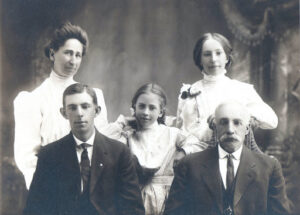Visiting my Grandmother Leatha Reams in Colorado a few years back, I was looking through some documents when I found what appeared to be a small hand written journal. After looking through it carefully, I realized these were the notes and musings of a school teacher. Sure enough, they were some lesson plans and even one of the childhood notebooks of my Great Aunt Ramona Outcalt. The pages gave you the sense of an organized mind, with a bent toward perfectionism and a curiosity for learning new things.
Ramona was the first child of John Outcalt and Florence (Flora) Johnson born on New Year’s Day in 1890 on a ranch near Gunnison, Colorado. Her father, John Outcalt was a successful rancher in the area, owning one of the largest ranches and whom had become a prominent figure in the community. John originally came from Brunswick, New Jersey. He was born on November 18th, 1845. His first employment that we know of was that of a shipbuilder, and in that trade he learned to be a good carpenter and craftsman. Like many others, he left for the West in 1870 and made his way to Denver.
The family tells the tale of him only having 27 cents in his pocket after arriving in Denver. With his carpenter tools in hand, he found gainful employment as carpenter. There is a rumor that he helped build the famous spiral staircase in the Brown Palace Hotel in Denver. At some point he got involved in a group of people looking to settle into the Gunnison area, known as the Richardson settlement. In 1875, he went with this group and ultimately, he and his brother William homesteaded about 1,400 hundred acres on the Southeast bank of the Gunnison river three miles north of Gunnison.
I have been on that ranch a few times. The family sold the ranch in 1994 to a man named Mike Clarke, who has since passed away. I spent an entire day with him driving around the property and talking through various things. He learned a lot about the ranch from my Great Aunt Vevarelle. She lived on the property after it was sold for several years. He told me many things about the development of the ranch since the time that John Outcalt officially filed the homesteading paperwork in 1880. First, John started growing and cultivating mountain meadow hay and other grains. The ranch, btw, still does this today. For well over a hundred years, those fields have grown mountain meadow hay. Nowadays they grow a very protein rich hay, known as Timothy Hay. This is used and purchased primarily for thorough bred horses. He quickly built a novel flooding methodology in which he diverts a portion of the river, and fills the first field. The runoff from that field is diverted into a culvert which then fills a ditch. Once that ditch fills, the second field is then flooded. This process continues until the water is returned to the Gunnison. This was an invention of his own, and has even been studied by water conservation experts as being a method that produces the least amount of water waste.
He was industrious for sure. He laid his own railroad tracks and connected those tracks to the railway in town and convinced the railroad to build a loading spur on his land. This became known as the Hay Spur, and he would eventually start to turn out over 800 carloads of hay per year. He also began to ship other produce to neighboring Crested Butte to feed the mule teams that were commonly used in the mining operations. John was very friendly with the Ute Indians. Chief Ouray and his outfit trusted the Outcalt’s and even contracted John to work to do some carpentry work for them in their nearby reservation.
Anyway, I could probably write an entire book on the early settlers of Gunnison County and their exploits. Just wanted to paint the picture of what life Ramona was born into. She had three younger sisters, and all of the girls became little ranch hands. I remember growing up how tough my Aunt Veverelle was. I remember visiting with her a few times. I never got more than a word out of her, however, she was clearly a hard working, tough as nails type of person. She probably was riding a horse the day she died (in her late 90s) or at least was thinking about it. My Great Grandmother, Delsie would tell me a lot of stories of her time on the ranch as a young girl. There was no discussion of Tom Boy or anything like that. You were an Outcalt, you worked on the ranch!
Ramona did well in school, and when she was of age, she was sent off to the University of Denver. She completed several years of school and graduated. She began teaching school for a while in a neighboring community of Castleton. There she taught for four years and then went on to teach at another school in Denver for a year. When she was 28, she was asked to be the principle of schools in Dolores, Colorado. This was a major role for such a young woman. This must have been a testament to her strong will, brilliant mind, and attention to detail. She was definitely on her way to a rewarding and successful career.
Then the Spanish Flu hit.
Gunnison, Colorado had a population at the time of 1,329, and 5,590 in the neighboring county areas. This was definitely a small mountain town. I remember as child visiting one year, when the temperature, with wind chill was almost 40 below. People were wrapping their cows to prevent them from freezing solid. When the flu hit Colorado, via Denver, it started to spread through communities in Colorado. Town after town started to report cases, and many casualties. Gunnison acted fast. They instituted their own quarantine. During the first major waves of the flu, their measures prevented any flu cases in town and only 2 in the county. The national news has been reporting this week, of what a model Gunnison was for this modern time. The county officials and a rather passionate local physician created a protective sequestration of barricades. They blocked roads heading into town. They would not let any traffic through the mountain pass and no one was allowed to get off the train at the rail depot. The closed schools, isolated anyone with even a hint of runny nose and prohibited any public gatherings. The local newspaper was equally behind the effort. They printed numbers and statistics from all over Colorado, and kept reinforcing how well preserved Gunnison was. Dr. Hanson, the zealous physican, kept passing even more restrictive rules. People were arrested for bypassing quarantine barriers and travelers were detained for days until they could be cleared.
Only one person died in the County of Gunnison during this wave of the Spanish flu in 1918. Ellen Gavette passed away on November 4th. She met her sister at the train station, coming home from a trip to Chicago. Her sister had a cold, they thought. A few days later, Ellen was dead. 25 years old.
Gunnison had their fair share of political problems. They were constantly being challenged and threatened with lawsuits and other recriminations. Schools remain closed, but pressure was mounting. However, everyone was relieved when news reports starting to circulate regarding the waning of the epidemic. On February 3, 1919, Dr. Hyatt called for the end of the protective sequestration and closer of the town of Gunnison. The town council agreed and the quarantine rules started to ease. Gunnison had been under this order for 4 months.
However, they did not avoid disaster. In the middle of March, a second wave of the Spanish Flu pandemic struck and Gunnison county was hit. No longer protected by sequestration, they had over 100 known cases of people falling ill and many more in surrounding areas. They lost 5 young people in a string of days and one of them was Ramona Outcalt. My Great Grandmother, Delsie, told me of that week. There was a funeral every day.
Ramona had come home from her employment in Dolores, because her father had fallen ill. John was 74 and in his weakened state could not manage the ranch. The younger children were helpful, but life in Gunnison was always rough and it took a special person to manage that and keep the household, livestock, horses, and the ranch hands all functioning. Ramona came home to help care for her father and run the family business. As she was nursing her father, my Great Grandmother and many in her family fell sick. One of their young children contracted the flu and had to be taken care of. Ramona took that on as well and she found herself taking care of her sister’s child. There is a larger story to that situation, maybe for another blog!
Anyway, Ramona was working very hard. Long hours in the fields, working the livestock, managing operations and caring for her father and niece. Unfortunately, she too also contracted the flu. She did not know it at first. She thought she just had a minor cold, sniffles for a week or so. She seemed to be getting better. Knowing the women in my family, she probably was already back hard at work, taking on all the problems before her. However, things went south real fast. Trouble with her breathing developed. A doctor was called, but before they could really help her, she died. She had full blown pneumonia in both lungs. She passed away at the age of 29.
She was joined by a few others on that Spring week. Roy Ruck, age 20. Charles April Jr, age 38 and Albert Smith, age 25. I imagine that these young people were working hard, pushing through a cold like any other Western Coloradian would do. Little did they know that their lungs were being attacked by a rapidly spreading virus and that they would be contracting pneumonia which would claim their lives rapidly. Gunnison got off light in that second round of the Spanish Flu, only claiming a few lives and finding the population well prepared and informed, however the family’s affected were devastated.
However, to my family, the lose was grievous as it would be to any family. For a young women like Ramona to find success in the school system was quite an accomplishment during the early 1900s. The newspaper said she was a “splendid young lady, so strong, hardy and well poised.” She would, unfortunately, not be the only tragedy in my family. There would be many more, life in the West was not easy. Our ancestors know that well.
This blog is just a reminder that we have been through this before, the people in this country survived and fought bravely. We lost many loved ones, like Ramona, but we carried on. We found out how to improve, to make things better. We overcame the challenges and learned from the failures. During this time of crisis, I am pleased to spend a little time to remember my Great Aunt and what she went through. BTW, I did not mention. She was a really good photographer. I know this because we have many pictures that she took that are surprisingly well intact, clear and well positioned. Ramona took this picture a few years before she died. The man with the mustache is John Outcalt. The young girl standing behind him is my Great Grandmother Delsie. Her younger sister, Vevarelle is by her side. She would be the one to eventually run the ranch by herself. Her mother Flora is standing. I have no idea who the young man is!

Guy Reams





Fascinating story! Thank you for sharing it. In 1944 my dad worked on leathas uncle Genes ranch. Dad called it the esty ranch and it was in Gunnison. He drove the hay wagon in temps that were often -10 below. If the temps rose above zero dad took his shirt off bc it was hot! Lol
Yes, and from what I heard they had your dad sleeping in the original house, which doubled as a pig pen! I still some pictures of that place, however, I have never been able to prove that story was true or not!
Great story! Thank you for sharing. Adam and I love hearing family history. When we traveled in that area of Colorado several years ago we had no idea about a family connection, but for some reason we both loved it and treasured our short time there more than other paces we have traveled.
Charles looks like John Outcalt!
Are you referring to the slightly vacant stare, the white hair, or the mustache!? 😉
All of the above!!the Stare, white hair and the mustache!! 😂